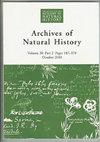Giant tortoises collected from Charles Island (Isla Floreana), Galápagos, during the voyage of USS Potomac, 1831–1834
IF 0.2
4区 哲学
Q3 HISTORY & PHILOSOPHY OF SCIENCE
引用次数: 0
Abstract
In 1834 Commodore John Downes (1784–1854) donated two live tortoises, a male and a female, to the Boston Society of Natural History that he had collected on Charles Island (Isla Floreana), Galápagos, during the circumnavigation of the USS Potomac. Both died shortly after arriving in Boston and were dissected. Their remains currently reside in the Harvard Museum of Comparative Zoology. By the beginning of the twentieth century it had become clear that each island had its own unique tortoise species, but most of the species’ names were based on specimens of unknown provenance. The two Potomac tortoises were almost the only specimens whose island of origin was actually known. The male was considered to be the holotype of the Floreana tortoise, with the suggested name Testudo galapagoensis (the currently accepted name is Chelonoidis niger). Genetic analysis, however, has revealed that the male actually came from Duncan Island (Isla Pinzón). Although the Potomac apparently remained at Floreana during its stay in the Galápagos, records of the trip indicate that a boat was sent to collect tortoises from Indefatigable Island (Isla Santa Cruz) and, possibly, Pinzón. The disposition of the female was reported as unknown, but there is a specimen in the Harvard collection that documentation identifies as the female. However, the specimen is a male, and is not the tortoise that Commodore Downes had donated to the Boston Society of Natural History. Although genetic analysis determined that this tortoise did indeed come from Floreana, its provenance is unclear.1831年至1834年,在波托马克号航空母舰的航行中,从加拉帕戈斯的查尔斯岛(弗洛里亚纳岛)采集的巨型陆龟
1834年,海军上将约翰·唐斯(1784-1854)向波士顿自然历史学会捐赠了两只活乌龟,一公一母,这两只乌龟是他在查尔斯岛(佛罗里达岛)收集的,在美国波托马克号环球航行期间,Galápagos。两人都在抵达波士顿后不久死亡,并被解剖。它们的遗骸目前存放在哈佛比较动物学博物馆。到20世纪初,人们已经清楚地认识到,每个岛屿都有自己独特的陆龟物种,但大多数物种的名字都是基于来历不明的标本。这两只波托马克象龟几乎是唯一已知其起源岛屿的标本。这只雄性龟被认为是弗洛里亚纳龟的原型,建议取名为Testudo galapagoensis(目前接受的名字是Chelonoidis niger)。然而,基因分析显示,这只雄性恐龙实际上来自邓肯岛(Isla Pinzón)。虽然波托马克河在Galápagos停留期间显然停留在弗洛里亚纳,但这次旅行的记录表明,一艘船被派往不知疲倦岛(圣克鲁斯岛),也可能是Pinzón收集乌龟。据报道,这只雌性恐龙的处置方式尚不清楚,但在哈佛大学的藏品中,有一件标本的文件证明是雌性恐龙。然而,这个标本是一只雄性乌龟,并不是唐斯准将捐赠给波士顿自然历史学会的那只乌龟。虽然基因分析确定这只乌龟确实来自弗洛里安那州,但它的来源尚不清楚。
本文章由计算机程序翻译,如有差异,请以英文原文为准。
求助全文
约1分钟内获得全文
求助全文
来源期刊

Archives of Natural History
HISTORY & PHILOSOPHY OF SCIENCE-
CiteScore
0.40
自引率
50.00%
发文量
34
审稿时长
>12 weeks
期刊介绍:
Archives of Natural History (formerly the Journal of the Society for the Bibliography of Natural History) publishes peer-reviewed papers on the history and bibliography of natural history in its broadest sense, and in all periods and all cultures. This is taken to include botany, general biology, geology, palaeontology and zoology, the lives of naturalists, their publications, correspondence and collections, and the institutions and societies to which they belong. Bibliographical papers concerned with the study of rare books, manuscripts and illustrative material, and analytical and enumerative bibliographies are also published.
 求助内容:
求助内容: 应助结果提醒方式:
应助结果提醒方式:


